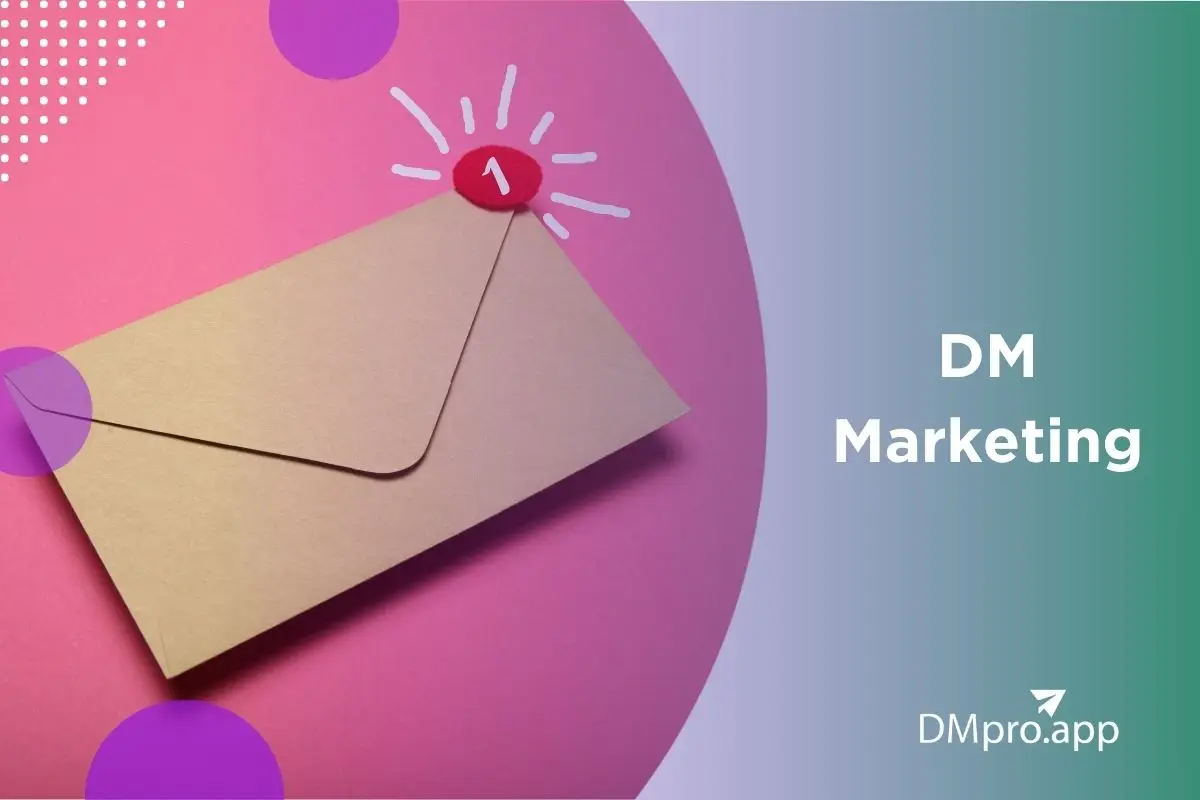Have you ever wanted to create a stronger connection with your audience on social media? What if I told you that the key to doubling your conversion rates could be hidden in your direct messages? Yes, that’s what you can get after learning about DM marketing.
Social media is no longer limited to likes and comments. You can gain a lot from that inbox you have never used! DM marketing utilizes private messaging on social media networks, such as Instagram, to establish personal relationships. When done correctly, it achieves better results than traditional marketing methods.
Apart from the strategies you should follow to be successful in this marketing method, using Instagram DM bots can also be helpful.
Table of Contents
ToggleWhat Is DM Marketing?
Let’s start with the definition of DM marketing.
Direct message (DM) marketing is how businesses connect with their audience directly on social media. It’s used to encourage interaction and build relationships with customers.
It’s also part of a broader direct marketing landscape that includes email and SMS, but social DMs shine for their immediacy and interactivity.
Direct message marketing offers real-time interactions and conversations with your audience, enabling two-way communication.
You can:
- Listen to customers,
- Address queries,
- Provide personalized recommendations,
- And gather valuable feedback.
However, it’s important to note that successfully implementing social media direct message marketing requires a strategic and efficient approach.
What Are the Benefits of DM Marketing?
Did you know that over 70% of consumers prefer direct messaging for personalized communication with a business? (Meta Report)
Direct messages offer several benefits for your business, including:
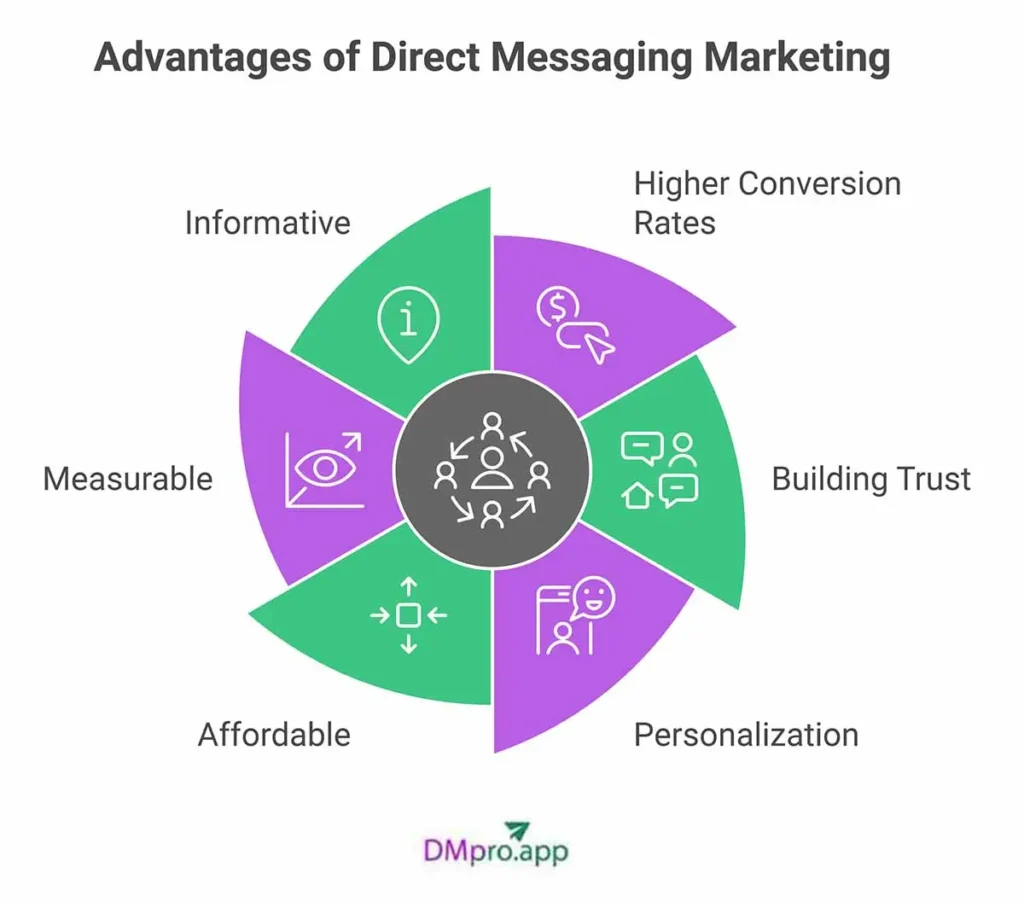
- Higher Conversion Rates: Direct, relevant outreach leads to quicker decisions, with strategies like soft offers boosting sales.
- Building Trust: Direct messaging allows for more genuine conversations, which helps brands build trust and collect testimonials.
- Personalization: You can personalize your messages by mentioning customers by name. Create customized messages for each user based on their activities, previous orders, and which of your posts they liked.
- Affordable: No need for paid ads; organic DMs can scale with automation tools, which are mostly free.
- Measurable: You can easily monitor the effectiveness of campaigns if your marketing messages encourage the customers to use a certain coupon code or take a specific action. You can use this to plan campaigns in the future.
- Informative: Unlike other types of advertising, you can provide comprehensive details about your goods, services, and costs.
DM Marketing Strategies and Best Practices
Now that you know how beneficial your DMs can be, let’s see how to create an effective DM marketing strategy:
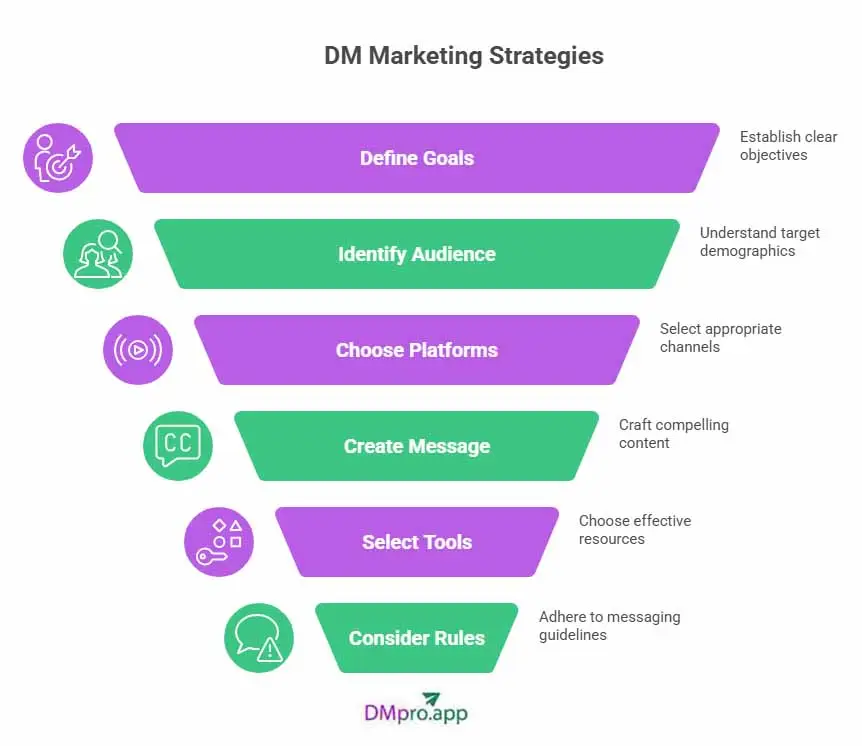
1. Define Your Goals
Clearly defining your goals is crucial to the success of DM marketing. Customer acquisition, loyalty, support, and engagement are a few examples of possible goals. By defining these, DM campaigns can be more precisely targeted and produce desired outcomes.
2. Identify Your Target Audience
Before sending messages out of the blue, consider your audience and what they like. Understand their need and create a message accordingly.
3. Choose Your Platforms
You can use direct messages on many platforms, but are they all worth your time?
Not all platforms are equal for DM marketing. Here’s a breakdown:
- Instagram: Ideal for visual brands, with features like quick replies and story mentions triggering DMs. Use it for influencer outreach or customer support.
- Facebook/Messenger: Supports advanced automation and the 24-hour messaging window. Strategies here focus on group engagements and reactivation sequences.
- LinkedIn: Perfect for B2B, where DMs (InMail) facilitate professional networking and lead generation.
- X (Twitter): Great for real-time conversations; recent posts highlight tools like broadcast messaging for targeted audiences. It’s useful for quick promotions or community building.
- Others (TikTok, WhatsApp): Emerging for DMs, especially WhatsApp for customer service integrations like those used by fashion brands.
Social Media Platforms’ DM Feature Comparison
Now, let’s quickly compare these platforms based on their DM features:
| Feature / Platform | Instagram DM | Facebook Messenger | TikTok DM | X (Twitter) DM | LinkedIn Messaging |
|---|---|---|---|---|---|
| Text Messaging | Yes | Yes | Yes | Yes | Yes |
| Images, Videos, GIFs | Yes (with filters, effects, drawings) | Yes (GIF and sticker library) | Yes | Yes | Yes |
| Voice Notes | Yes | Limited | Limited | No | No |
| Voice/Video Chat | Yes | Yes | No | No | No |
| Quick Reply Buttons | Yes | Yes | Limited | No | No |
| DM Automation & Chatbots | Via Instagram API, comment triggers | Strong (auto replies, chatbots support) | Limited | Limited | No |
| Message Restrictions | Can restrict who can DM (privacy settings) | Typically open, can restrict | DM if both follow or settings allow | Some restrictions, DM from followers or open accounts | Messages to connections only (InMail paid for outsiders) |
| Group Messaging | Yes | Yes | Yes | Yes | No |
| Link Sharing | Yes | Yes | Yes | Yes | Yes |
| Message Requests Folder | Yes (for non-followers) | No | Yes | Yes | No |
| Disappearing Messages | Available (Vanish Mode) | Limited | No | No | No |
| User Base (Approx.) | 2 billion | 1.3 billion | 1 billion+ | 500 million | +900 million |
| Best Use Case | Influencer marketing, brand engagement | Automated customer service, lead capture, marketing | Influencer chat, casual brand interaction | Fast customer service, media pitches | B2B networking, job pitches, partnerships |
As you can see, direct messaging might not be the same on all platforms. However, in most cases, you can sell on Instagram DM using this approach as it’s more DM-friendly both for businesses and customers.
4. Create Ideal Message
A good direct message is conversational, captivating, and clear. Here are the things you need to consider in this step:
- Tone of Voice: Align your messages with your brand’s voice. It’s essential to maintain consistency.
- Personalization: Address users by name, reference past interactions.
- Speak Directly: Get to the point quickly. Your audience won’t take a long time to read what you say.
- Call-to-Actions (CTAs): Don’t forget to add a clear Call-to-Action to lead them to the next steps and inspire further interaction.
DM Marketing Examples:
- “Hey Sarah 👋 Thanks for following us! Here’s a 10% discount code just for you: WELCOME10.”
- We’re giving our followers early access to our Black Friday sale 🎉 Click here to shop before it’s public!”
- “You mentioned you love skincare 🌿. We think you’d enjoy our new vitamin C serum — want me to send you a free sample code?”
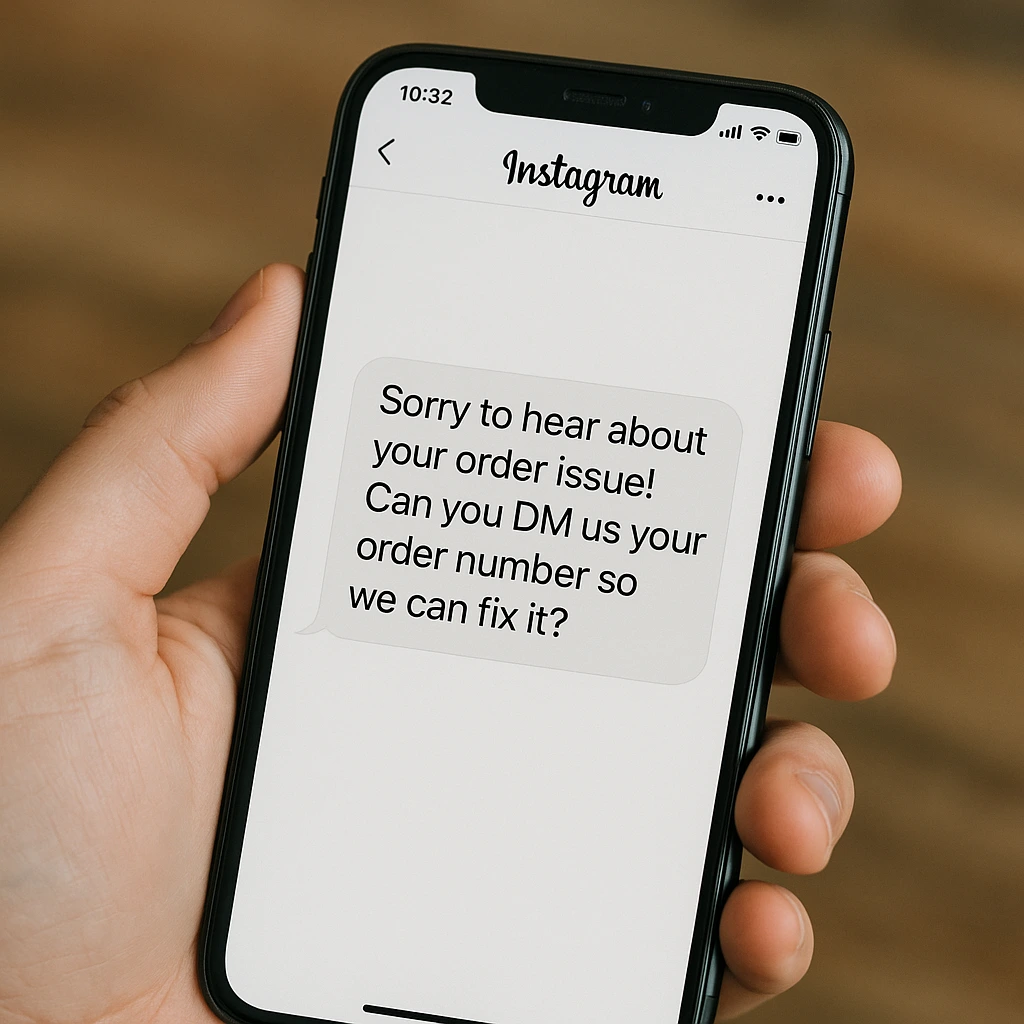
5. Select the Correct Tools
Social media messaging can be maximized with the right tools.
- Incorporate automation features to streamline FAQs, auto-reply messages, or sending Instagram welcome messages.
- Use DM apps to monitor engagement metrics and smart targeting.
- Consider CRM integration to aid in the management of customer data.
Note: Emphasize balancing automation with a human touch to avoid sounding robotic.
6. Consider Messaging Rules
It’s essential to be aware of the rules and restrictions about sending messages on social media platforms. For example, if you’re using Instagram for direct message marketing, it’s important to understand Instagram’s message limits to prevent your account from being banned or blocked.
Best Practices for Maximizing Your Direct Message Marketing Impact
So far, we have learned a lot about how to implement DMs in our marketing strategies. But how can we improve it and make it more effective? Follow these tips:
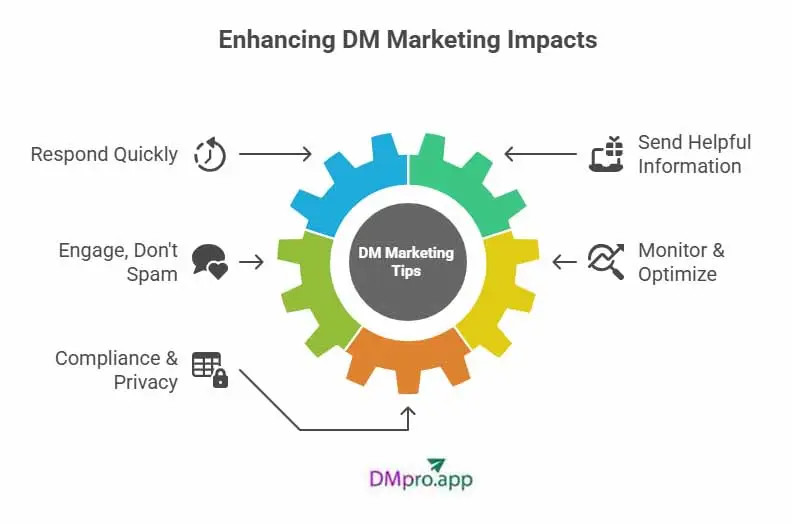
- Respond Quickly: It’s essential to respond to messages as quickly as possible. Using DM automation tools or setting up an FAQ can be helpful here.
- Send Helpful Information: Whether you are starting the message or replying to your customers, you should always offer valuable information, exclusive deals, or solutions, not just sales pitches.
- Engage, Don’t Spam: Focus on natural conversations rather than promotional texts.
- Monitor & Optimize: Track key metrics (response rates, conversion rates, customer satisfaction) and adjust your strategy based on performance.
- Compliance & Privacy: Adhere to platform rules and data privacy regulations. Read more about Facebook’s 24-hour rule, and laws like GDPR or CAN-SPAM.
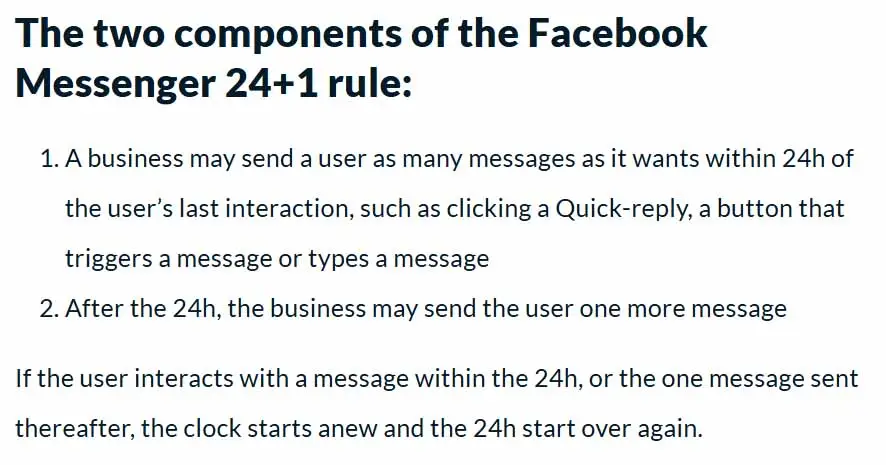
The Challenges of DM Marketing
While direct message marketing holds immense potential for businesses, it also comes with its fair share of challenges, including:
- Personalization at Scale: As your customer base grows, personalizing and sending direct messages to each individual becomes time-consuming. You should invest time in creating templates, inserting customer details dynamically, and automating the sending process. Every recipient feels valued and engaged effortlessly.
- Efficient Campaign Management: Managing multiple DM campaigns can be overwhelming, especially when it involves tracking responses, organizing customer data, and ensuring timely follow-ups.
- Analytics and Insights: Although DMs are easily trackable, this process can be challenging without proper analytics and insights. This makes using tools designed for this purpose more important.
What Can You Do to Overcome These Challenges?
On DMpro, we offer different services for DM marketing, such as mass DMing on Instagram, sending personalized messages to your audiences, and analyzing the final result. All can be done by our experts in this field, who know how to create messages that not only are appealing to your audience but also comply with platforms’ messaging rules and regulations.
Is DM Marketing Right for Your Business?
If you handle message marketing carefully, it may be a great opportunity for your business, but not all businesses will succeed with it. How can you determine whether direct messaging is appropriate for your business model or industry? Begin with some introspection:
- Can you easily locate and identify your target audience on social media platforms like Twitter, LinkedIn, and Instagram?
- Does your audience frequently communicate, ask questions, or provide feedback via direct messages?
- Would a personal touch—such as customized suggestions, special deals, or in-person customer support—improve your product or service?
- Does real-time communication and relationship-building enhance your sales process, or is it primarily consultative?
Finally, consider whether you would feel comfortable having a private chat with a customer at all.
Direct messaging is a good option to consider if connecting with your audience on social media feels natural. Otherwise, you might want to concentrate on anything else.
Additionally, keep in mind that not all messages or replies will be positive. Prepare to respond politely to every message you receive.
Conclusion
DM Marketing presents a special opportunity to add value and establish trust by personalizing that process. It can also be considered one of the best Instagram marketing strategies for small businesses, as it’s cost-effective and doesn’t have many challenges.
Try using direct messages (DMs) as part of your larger social media marketing strategy without fear. Your genuine relationships have the potential to be a significant factor in your long-term success.
FAQs
Focus on context and value instead of being too promotional. Keep your writing concise and friendly. Always prioritize helpful information and build engagement before making requests. And the most important part: don’t forget about platforms’ messaging rules.
Marketing via direct messages can have its own risks if it is done in the wrong way. Here is a list of possible outcomes:
– Being flagged as spam
– Getting blocked or reported
– Account restrictions or bans
– Damaging brand reputation if done poorly
To see whether your DM strategy is successful, you should track:
– Reply rates,
– Conversion rates,
– Response times,
– Drop-off points in conversations.
It depends on your audience and your marketing approaches. Meanwhile, most businesses consider Instagram a better option, as its users are more ready to receive messages in their inboxes.

